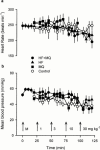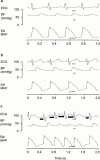Potentiation of halofantrine-induced QTc prolongation by mefloquine: correlation with blood concentrations of halofantrine
- PMID: 11156578
- PMCID: PMC1572561
- DOI: 10.1038/sj.bjp.0703823
Potentiation of halofantrine-induced QTc prolongation by mefloquine: correlation with blood concentrations of halofantrine
Abstract
1. The antimalarial drug halofantrine can prolong the QT interval and this may be enhanced by prior use of mefloquine. This possible interaction has been investigated by examining the effects of halofantrine and mefloquine alone and in combination. 2. In anaesthetized rabbits (n=6 per group), halofantrine given as bolus doses of 1, 3, 10, and 30 mg kg(-1) at 25 min intervals dose-dependently prolonged the rate-corrected QT (QTc) interval from 313+/-12 ms pre-drug to 410+/-18 ms after the highest dose. Similar doses of mefloquine did not alter QTc intervals significantly. The highest dose of mefloquine (30 mg kg(-1)) caused cardiac contractile failure. 3. Pretreatment with 3 mg kg(-1) mefloquine 25 min before the first dose of halofantrine potentiated the effects of all doses of halofantrine on QTc intervals. 4. The blood concentrations of halofantrine were two to six times higher in the group pretreated with mefloquine compared to the halofantrine alone group; e.g. 1.03+/-0.17 and 0.16+/-0.02 microM respectively after 1 mg kg(-1) halofantrine. There was a significant correlation between blood halofantrine concentrations and QTc intervals (r=0.673). Even after making allowance for overestimation of the potency of halofantrine that may result from the hypokalaemia that is prevalent in anaesthetized rabbits, these effects occurred with concentrations of halofantrine that are found in clinical use. 5. These data indicate clearly that while mefloquine does not alter QTc intervals itself, it does enhance the effects of halofantrine by increasing the circulating concentration of halofantrine.
Figures





Similar articles
-
Comparison of the acute cardiotoxicity of the antimalarial drug halofantrine in vitro and in vivo in anaesthetized guinea-pigs.Br J Pharmacol. 1997 Oct;122(3):563-9. doi: 10.1038/sj.bjp.0701402. Br J Pharmacol. 1997. PMID: 9351516 Free PMC article.
-
Evaluation of the impact of altered lipoprotein binding conditions on halofantrine induced QTc interval prolongation in an anaesthetized rabbit model.J Pharm Pharmacol. 2004 Jan;56(1):69-77. doi: 10.1211/0022357022520. J Pharm Pharmacol. 2004. PMID: 14980003
-
The effects of antimalarial drugs on ventricular repolarization.Am J Trop Med Hyg. 2002 Jul;67(1):54-60. doi: 10.4269/ajtmh.2002.67.54. Am J Trop Med Hyg. 2002. PMID: 12363064 Clinical Trial.
-
Mechanism of cardiotoxicity of halofantrine.Clin Pharmacol Ther. 2000 May;67(5):521-9. doi: 10.1067/mcp.2000.106127. Clin Pharmacol Ther. 2000. PMID: 10824631 Review.
-
Clinical pharmacokinetics of halofantrine.Clin Pharmacokinet. 1994 Aug;27(2):104-19. doi: 10.2165/00003088-199427020-00003. Clin Pharmacokinet. 1994. PMID: 7955774 Review.
Cited by
-
Generation of a Homozygous Transgenic Rat Strain Stably Expressing a Calcium Sensor Protein for Direct Examination of Calcium Signaling.Sci Rep. 2015 Aug 3;5:12645. doi: 10.1038/srep12645. Sci Rep. 2015. PMID: 26234466 Free PMC article.
-
Proarrhythmic potential of halofantrine, terfenadine and clofilium in a modified in vivo model of torsade de pointes.Br J Pharmacol. 2002 Feb;135(4):1003-12. doi: 10.1038/sj.bjp.0704550. Br J Pharmacol. 2002. PMID: 11861329 Free PMC article.
-
New fixed-dose artesunate-mefloquine formulation against multidrug-resistant Plasmodium falciparum in adults: a comparative phase IIb safety and pharmacokinetic study with standard-dose nonfixed artesunate plus mefloquine.Antimicrob Agents Chemother. 2010 Sep;54(9):3730-7. doi: 10.1128/AAC.01187-09. Epub 2010 Jun 14. Antimicrob Agents Chemother. 2010. PMID: 20547795 Free PMC article. Clinical Trial.
-
Piperaquine Population Pharmacokinetics and Cardiac Safety in Cambodia.Antimicrob Agents Chemother. 2017 Apr 24;61(5):e02000-16. doi: 10.1128/AAC.02000-16. Print 2017 May. Antimicrob Agents Chemother. 2017. PMID: 28193647 Free PMC article. Clinical Trial.
-
Effect of experimental hyperlipidaemia on the electrocardiographic effects of repeated doses of halofantrine in rats.Br J Pharmacol. 2010 Nov;161(6):1427-40. doi: 10.1111/j.1476-5381.2010.00983.x. Br J Pharmacol. 2010. PMID: 20698852 Free PMC article.
References
-
- BARRETT T.D., MCLEOD B.A., WALKER M.J.A. A model of myocardial ischemia for the simultaneous assessment of electrophysiological changes and arrhythmias in intact rabbits. J. Pharmacol. Toxicol. Methods. 1997;37:27–36. - PubMed
-
- BARRETT T.D., WALKER M.J.A. Glibenclamide does not prevent action potential shortening induced by ischemia in anesthetized rabbits but reduces ischemia-induced arrhythmias. J. Mol. Cell. Cardiol. 1998;30:999–1008. - PubMed
-
- BAUNE B., FLINOIS J., FURLAN V.F.G., TABURET A., BECQUEMONT L., FARINOTTI R. Halofantrine metabolism in microsomes in man: major role of CYP 3A4 and CYP 3A5. J. Pharm. Pharmacol. 1999a;51:419–426. - PubMed
-
- BAUNE B., FURLAN V., TABURET A., FARINOTTI R. Effect of selected antimalarial drugs and inhibitors of cytochrome P-450 3A4 on halofantrine metabolism by human liver microsomes. Drug Metab. Dispos. 1999b;27:565–568. - PubMed
Publication types
MeSH terms
Substances
LinkOut - more resources
Full Text Sources

